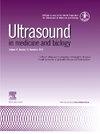Estimation of In Vivo Human Carotid Artery Elasticity Using Arterial Dispersion Ultrasound Vibrometry
IF 2.4
3区 医学
Q2 ACOUSTICS
引用次数: 0
Abstract
Objective
Arterial stiffening serves as an early indicator for a variety of cardiovascular diseases. Arterial Dispersion Ultrasound Vibrometry (ADUV) is a method that leverages acoustic radiation force to stimulate arterial wall motion, assess wave propagation characteristics, and subsequently calculate the arterial shear modulus. Previously, we introduced an inversion technique based on a guided cylindrical wave model, which proved effective in rubber tube phantom experiments. In this study, we broaden the scope of our investigation from phantom experiments to in vivo examination of common carotid arteries in human subjects, identify the challenges, and provide solutions, leading to a systematic protocol for ADUV application and robust estimation of the elastic modulus of common carotid arteries.
Methods
We achieve this by analyzing ADUV data from 59 subjects categorized as (a) confirmed atherosclerotic cardiovascular disease (n = 27), (b) with cardiovascular risk factors (n = 20), and (c) healthy (n = 12). A crucial aspect of this work is the development of metrics to differentiate high-quality ADUV data from unusable data.
Results and Conclusions
With the proposed metrics, in our cohort, we observed 82% of diameter data and 78% of motion data as usable data. Future work will involve applying this protocol to a larger cohort with subsequent statistical analysis to assess and validate the resulting biomarkers.
利用动脉弥散超声波测振法估算体内人体颈动脉弹性
目的:动脉僵化是多种心血管疾病的早期指标。动脉弥散超声波测振法(ADUV)是一种利用声辐射力刺激动脉壁运动、评估波传播特性并随后计算动脉剪切模量的方法。在此之前,我们介绍了一种基于引导圆柱波模型的反演技术,该技术在橡胶管模型实验中被证明是有效的。在本研究中,我们将研究范围从模型实验扩大到人体颈总动脉的活体检查,确定了面临的挑战并提供了解决方案,从而形成了应用 ADUV 和稳健估算颈总动脉弹性模量的系统方案:为此,我们对 59 名受试者的 ADUV 数据进行了分析,这些受试者被分为:(a)确诊患有动脉粥样硬化性心血管疾病者(27 人);(b)存在心血管风险因素者(20 人);以及(c)健康者(12 人)。这项工作的一个重要方面是制定指标,以区分高质量 ADUV 数据和不可用数据:在我们的队列中,使用提出的指标,我们观察到 82% 的直径数据和 78% 的运动数据为可用数据。未来的工作将包括在更大的群体中应用此方案,并进行后续统计分析,以评估和验证由此产生的生物标志物。
本文章由计算机程序翻译,如有差异,请以英文原文为准。
求助全文
约1分钟内获得全文
求助全文
来源期刊
CiteScore
6.20
自引率
6.90%
发文量
325
审稿时长
70 days
期刊介绍:
Ultrasound in Medicine and Biology is the official journal of the World Federation for Ultrasound in Medicine and Biology. The journal publishes original contributions that demonstrate a novel application of an existing ultrasound technology in clinical diagnostic, interventional and therapeutic applications, new and improved clinical techniques, the physics, engineering and technology of ultrasound in medicine and biology, and the interactions between ultrasound and biological systems, including bioeffects. Papers that simply utilize standard diagnostic ultrasound as a measuring tool will be considered out of scope. Extended critical reviews of subjects of contemporary interest in the field are also published, in addition to occasional editorial articles, clinical and technical notes, book reviews, letters to the editor and a calendar of forthcoming meetings. It is the aim of the journal fully to meet the information and publication requirements of the clinicians, scientists, engineers and other professionals who constitute the biomedical ultrasonic community.

 求助内容:
求助内容: 应助结果提醒方式:
应助结果提醒方式:


